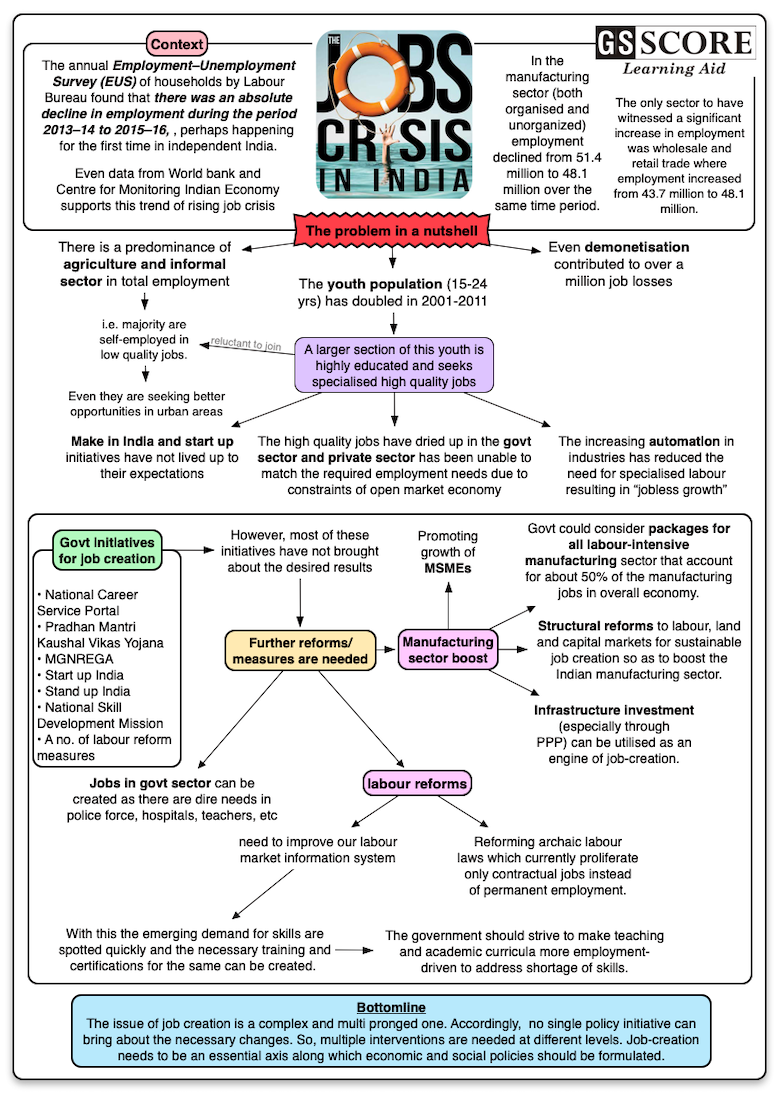

The annual Employment–Unemployment Survey (EUS) of households by Labour Bureau found that there was an absolute decline in employment during the period 2013–14 to 2015–16, except a marginal improvement in 2010-12.
Issue
Context:
- The annual Employment–Unemployment Survey (EUS) of households by Labour Bureau found that there was an absolute decline in employment during the period 2013–14 to 2015–16, except a marginal improvement in 2010-12.
About:
Major highlights of the Survey:
- It shows a decline in total employment from 480.4 million (2013-14) to 467.6 million (2015-16), perhaps happening for the first time in independent India.
- In the manufacturing sector (both organised and unorganized) employment declined from 51.4 million to 48.1 million over the same time period.
- The only sector to have witnessed a significant increase in employment was wholesale and retail trade where employment increased from 43.7 million to 48.1 million.
- Unemployment rate is rising. There was 5% of labour force jobless in the FY-2016. The rise in unemployment amongst the youth is the most worrying thing. Unfortunately, the jobs are not growing and as a result the number of youth in agriculture is rising which is opposite to that of 2012 conditions.
Background:
India’s labour market is characterised by three features:
- There is a predominance of agriculture and the informal sector in total employment. It implies that a majority of workers are self-employed in low quality employment and there has been a slow growth of labour productivity in these sectors.
- Large poverty and distress also lead to a situation of vulnerability where participation in the labour market is not out of choice but is governed by changes in the income level. This is true for a majority of workers classified as reserve labour and includes women, children and the elderly.
- The decision to enter and exit the labour market is more a response to household earnings.
Analysis
Youth and Unemployment
- There is a silent revolution across the country in terms of education of young population.
- As the population of India's youth (aged 15-24 years) more-than-doubled during 2001-2011, the unemployment rate among this section rose to 20 per cent.
- The unemployment rate among the educated is not only higher compared to the uneducated; it also increases with higher levels of education.
- In both rural and urban areas, the unemployment rate among graduates and above is much higher than among those with secondary education and above.
- One of the reasons for it is unwillingness of educated to join low-grade informal jobs, but at the same time, sufficient regular salaried jobs are not available for them.
- The demand of traditionally landed castes like the Patidars, Gujjars, Jats, Marathas and Kapus for job reservations can be seen as a symptom of aspirations for government jobs.
- Jobs in government are not growing in last 20 years.
Concerns:
- There is a slowdown in the economy but in contrast India is growing steadily. At the same time the employment is also slowing down steadily as well.
- Unutilized employment potential in the phase of demographic transition will only lead to a demographic catastrophe.
- Despite consistent growth in GDP, corresponding job creation has not taken place.
- About 1.4 million people have lost their jobs post demonetisation than at the same time what does the growth is attributed to.
- Jobless growth is a dangerous trend as it furthers social inequality.
Challenges:
- The increasing diversification of the economy together with acceleration in economic growth has resulted in structural changes in the nature of the job market.
- The average annual growth rate of overall employment in both the organised and un-organised sectors has decelerated primarily due to slower growth in agricultural employment, with the absolute number of persons employed in agriculture showing a decline.
- Agriculture can no longer support half the population and the fresh pressure on jobs will come from rural workers migrating to urban areas for jobs.
- Advanced Technology: Earlier for a task many were required to do a work but now due to the advanced technology (Ex: Artificial Intelligence) only one person can do many people’s work.
- Employment in sectors like trade, transport, construction, financial services, storage and communications has grown faster than the average and the share of these sectors in total employment has increased. This reflects the structural changes in products markets in the post-reform period.
- The schemes like Smart Cities Project have the potential to create huge amount of jobs but such steps cannot be unilateral as states have to also come on board.
- The flagship program of government like Make in India & Skill India has not been able to generate employment opportunities.
- There is also a lack of industrial policy since the economic reforms began, though there has been a National Manufacturing Policy in 2011 but it never got implemented due to policy paralysis.
Government initiatives to address job crisis:
- National Career Service portal was launched serving as a common platform connecting job-seekers, employers, skill providers, placement organizations and counselors.
- Pradhan Mantri Kaushal Vikas Yojana (PMKVY) a skill development scheme to help young people learn industry-relevant skills.
- MGNREGA has contributed to lowering unemployment in rural areas.
- Start Up India, Stand Up India, and National Skill Development Mission.
- In a major initiative for ensuring compliance and promoting ease of doing business, the government has initiated a number of labour reform measures.
Remedies to tackle India's job crisis:
- Improving labour market information system will go long way. It will spot emerging demand for skills quickly and the necessary training and certifications for the same can be generated.
- Structural reforms to labour, land and capital markets for sustainable job creation so as to boost the Indian manufacturing sector is required.
- The academic curricula need to be made more employable-driven to address shortage of skills.
- Infrastructure investment (especially through PPP) can be utilised as an engine of job-creation.
- Agriculture sector have to sustain the growth of 4% to stop the people shifting to agriculture for jobs. Government should give packages for all labour-intensive manufacturing sector (Woods & furniture, leather, food processing, textiles, & garments in apparel) that account for about 50% of the manufacturing jobs in overall economy.
- Promoting growth of Micro, small, and medium enterprises (MSME) is critical from the perspective of job creation which has been recognized as a prime mover of the development agenda in India.
- Another structural change needed is a shift from informal sector employment to formal sector employment. A shift away from the unorganized/informal sector to the organized/formal sector is desperately needed if we want to meet the expectations of the young.
- Need of smart urbanization.The link between good urbanization and jobs growth is positive, and unless India’s urbanization is concentrated in narrower areas and serviced by good infrastructure, job creation will be sub-optimal.
- The jobs in the government can be grown as there is a dire need in police force, doctors & nurses, judges, secondary school teachers etc. which will provide jobs in reserved categories.
Learning Aid
Practice Question:
Despite being one of the fastest growing economies in the world, India is facing serious job crisis. Explain the reasons behind this. Also elaborate the measures taken by the government.


